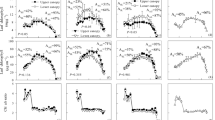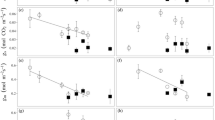Summary
We investigated relationships between light availability, diel acid fluctuation, and resource storage in the arborescent cactus Opuntia excelsa growing in western Mexico. We compared canopy and understory individuals from a deciduous forest as well as open-grown plants of the same approximate size as those in the understory. During the wet season light availability and daily fluctuations in titratable acidity (an index of carbon uptake) were lower in the understory than in unshaded habitats. In the dry season all plants had reduced levels of acid fluctuation, with the smallest individuals, regardless of habitat, showing the greatest reduction. These data suggest that light availability in the forest understory constrains carbon assimilation during the wet season, but that a factor associated with plant size, possibly water status, limits carbon gain during the dry season. Plants in all habitats remained physiologically active for at least five months into the dry season. We suggest that this was possible due to the maintenance of constant concentrations of water and nitrogen in the photosynthetically active chlorenchyma. Parenchyma in terminal cladodes showed a different seasonal pattern of resource storage; water content and nitrogen concentration were reduced from the wet to the dry season in the parenchyma. Using the parenchyma to supply photosynthetic tissues during times of reduced resource availability allows O. excelsa to assimilate carbon during times of the year when most other trees in the forest are leafless.
Similar content being viewed by others
References
Adams WW III (1988) Photosynthetic acclimation and photoinhibition of terrestrial and epiphytic CAM tissues growing in full sunlight and deep shade. Aust J Plant Physiol 15: 123–134
Adams WW III, Osmond CB, Sharkey TD (1987) Responses of two CAM species to different irradiances during growth and susceptibility to photoinhibition by high light. Plant Physiol 83: 213–218
Backeberg K (1976) Cactus Lexicon. Blandford Press Ltd., Poole, Dorset
Bullock SH (1986) Climate of Chamela, Jalisco and trends in the south coastal region of Mexico. Arch Clim, Meteor, Bioclim, Ser B 36: 297–316
Bullock SH, Solís-Magallanes JA (1990) Phenology of canopy trees of a tropical deciduous forest in Mexico. Biotropica 22: 22–35
Cockburn W (1983) Stomatal mechanism as the basis of the evolution of CAM and C4 photosynthesis. Plant Cell Envir 6: 275–279
Cody M (1986) Distribution and morphology of columnar cacti in tropical deciduous woodland, Jalisco, Mexico. Vegetatio 66: 137–145
Hanscom Z, Ting I (1977) Physiological responses to irrigation in Opuntia basilaris Engelm. & Bigel. Bot Gaz 138: 159–167
Kluge M, Ting I (1978) Crassulacean Acid Metabolism. Springer-Verlag, Berlin
Lott EJ, Bullock SH, Solís-Magallanes JA (1987) Floristic diversity and structure of upland and arroyo forests of coastal Jalisco. Biotropica 19: 228–235
Luttge U (1987) Carbon dioxide and water demand: Crassulacean acid metabolism (CAM), a versatile ecological adaptation exemplifying the need for integration in ecophysiological work. New Phytol 106: 593–629
Luttge U, Ball E (1987) Dark respiration of CAM plants. Plant Physiol Biochem 25: 3–10
Luttge U, Medina E, Cramp WJ, Lee HSJ, Popp M, Smith JAC (1989) Ecophysiology of xerophytic and halophytic plants of a coastal alluvial plain in Venezuela. II. Cactaceae. New Phytol 111: 245–251
Martin CE, Christianson NL, Strain BR (1981) Seasonal patterns of growth, tissue acid fluctuations, and 14CO2 uptake in the Crassulacean acid metabolism epiphyte Tillandsia usneoides L. (Spanish moss). Oecologia 49: 297–304
Martin CE, McLeod KW, Eades CA, Pitzer AF (1985) Morphological and physiological responses to irradiance in the CAM epiphyte Tillandsia usneoides L. (Bromeliaceae). Bot Gaz 146: 489–494
Metcalfe CR, Chalk L (1950) Anatomy of the Dicotyledons. Clarendon Press, Oxford p. 702
Medina E, Delgado M, Troughton JH, Medina JD (1977) Physiological ecology of CO2 fixation in Bromeliaceae. Flora 166: 137–152
Medina E, Olivares E, Diaz M (1986) Water stress and light intensity effects on growth and nocturnal acid accumulation in a terrestrial CAM bromeliad (Bromelia humilis Jacq) under natural conditions. Oecologia 70: 441–446
Neales TF, Patterson AA, Hartney VJ (1968) Physiological adaptation to drought in the carbon assimilation and water loss of xerophytes. Nature 219: 469–472
Nobel PS (1977) Water relations and photosynthesis of a barrel cactus, Ferocactus acanthodes, in the Colorado desert. Oecologia 27: 117–133
Nobel PS (1983) Nutrient levels in cacti in relation to nocturnal acid accumulation and growth. Am J Bot 70: 1244–1253
Nobel PS (1988) Environmental Biology of Agaves and Cacti. Cambridge Univ. Press. Cambridge
Nobel PS, Hartsock TL (1983) Relationships between photosynthetically active radiation, nocturnal acid accumulation, and CO2 uptake for a Crassulacean acid metabolism plant, Opuntia ficusindica. Plant Physiol 71: 71–75
Osmond CB (1978) Crassulacean acid metabolism: a curiosity in context. Ann Rev Plant Physiol 29: 379–414
Osmond CB (1984) CAM. Regulated metabolism for all seasons. In: Advances in Photosynthetic Research. Sybesma C (ed.) vol. 3 pp 557–563
Pfitsch WA, Smith AP (1988) Growth and photosynthesis of Aechmea magdalenae, a terrestrial CAM plant in tropical moist forest, Panama. J Trop Ecol 4: 199–207
Rich PM (1989) A manual for hemispherical canopy analysis. Los Alamos National Laboratory Report LA-11733-M
Rich PM (1990) Characterizing plant canopies with hemispherical photographs. Rem Sens Rev 5: 13–29
Szarek SR, Ting I (1974) Seasonal patterns of acid metabolism and gas exchange in Opuntia basilaris. Plant Physiol 54: 76–81
Szarek SR, Ting I (1975) Physiological responses to rainfall in Opuntia basilaris (Cactaceae). Am J Bot 62: 602–609
Szarek SR, Troughton JH (1976) Carbon isotope ratios in Crassulacean acid metabolism plants: Seasonal patterns from plants in natural stands. Plant Physiol 58: 367–370
Teeri JA (1984) Seasonal variation in crassulacean acid metabolism Dudleya blochmanae (Crassulaceae). Oecologia 64: 68–73
Tissue DT, Yakir D, Nobel PS (1991) Diel water movement between parenchyma and chlorenchyma of two desert CAM plants under dry and wet conditions. Plant Cell Envir 14: 407–413
Winter K, Osmond CB, Hubick KT (1986) Crassulacean acid metabolism in the shade. Studies on an epiphytic fern, Pyrrosia longifolia, and other rainforest species from Australia. Oecologia 68: 224–230
Author information
Authors and Affiliations
Rights and permissions
About this article
Cite this article
Lerdau, M.T., Holbrook, N.M., Mooney, H.A. et al. Seasonal patterns of acid fluctuations and resource storage in the arborescent cactus Opuntia excelsa in relation to light availability and size. Oecologia 92, 166–171 (1992). https://doi.org/10.1007/BF00317359
Received:
Accepted:
Issue Date:
DOI: https://doi.org/10.1007/BF00317359




